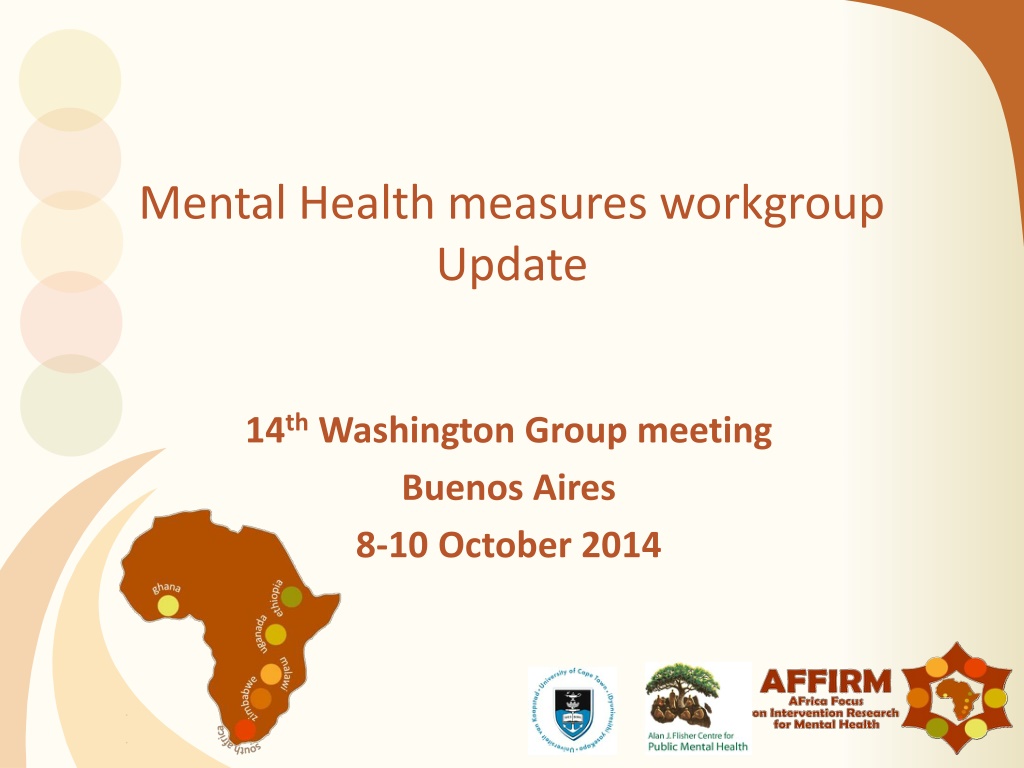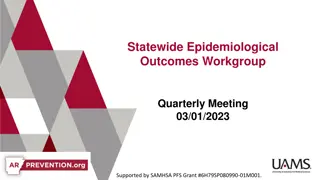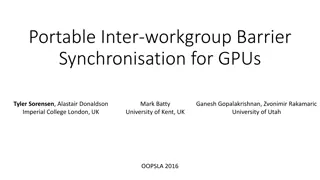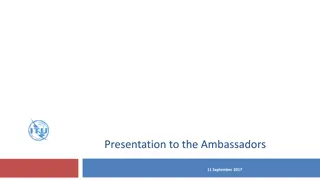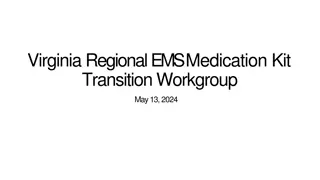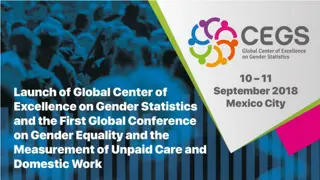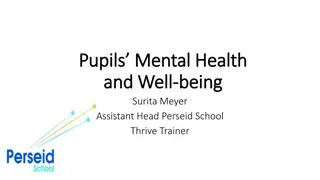Insights on Mental Health Measures Workgroup Update Meeting in Buenos Aires
Discussion at the 14th Washington Group meeting in Buenos Aires focused on important considerations surrounding mental health measures, including the revision of commonly used instruments, the importance of mental health in public health, and the challenges in assessing common mental disorders. The meeting highlighted the growing awareness of mental health issues and the role of such measures in global mental health goals.
Download Presentation

Please find below an Image/Link to download the presentation.
The content on the website is provided AS IS for your information and personal use only. It may not be sold, licensed, or shared on other websites without obtaining consent from the author. Download presentation by click this link. If you encounter any issues during the download, it is possible that the publisher has removed the file from their server.
E N D
Presentation Transcript
Mental Health measures workgroup Update 14thWashington Group meeting Buenos Aires 8-10 October 2014
Overview Discussion document revised Key considerations Review of most commonly used instruments Proposal for next steps
Revising the background document Based on inputs from group members and a few mental health experts Contextualises the importance of Mental health in public health and disability statistics Raises important issues around current measures used Clinical rating scales used in surveys by lay interviewers Content of survey measures: Common mental disorders (CMD) and/or severe mental disorders (SMD) Uni- or multidimensional constructs Provides some country examples (e.g. Latin American countries, Eurostat)
Main points from background document MH measures are important Growing awareness of mental health problems Movement for Global Mental Health Inclusion the sustainable development goals (MH and poverty; unmet needs) What to focus on: common mental disorders (Anxiety, depression and possibly PTSD) Severe mental illness Different kinds of questions? Do screening or diagnosis Uni- or multi-dimensional E.g. Just depression or just anxiety or combination Taking into account existing measures and how these are used
Uses of common scales: Clinical screening and/or diagnosis Research tool identifying participants, monitoring change over time, categories of severity Surveys Different scoring approaches: Algorithm for combining all questions into a summary score with cutoff points Scales; composite score Individual question analysis WG ES-F
Workplan set out in October 2013 Define the aim and the approach in measuring mental health (or mental disability?) Review of all the work carried out in Europe and prepare additional research to determine the suitability of these for other regions of the world. Review any work in other regions of the world. Consideration of the relationship between mental health measures and measures of Quality of Life, Wellbeing and satisfaction. Separating out measures of severe mental illness and CMDs and deciding whether to include both or only CMDs in a proposed module.
Common instruments for MH Depression and anxiety measures Patient health questionnaire (PHQ2, PHQ8, PHQ9) Kessler scales (K6, K10) Centre for Epidemiological Studies Depression scale (CES-D) Generalised anxiety disorder (GAD2, GAD7) Modules from other scales e.g. MH Inventory from SF36 PTSD Primary care PTSD screen (PC-PTSD) Washington Group extended set questions: Anxiety Depression (Fatigue) (Pain)
Patient health questionnaire - PHQ PHQ full version led to many variations PHQ2 mild and moderate depression; screening; 0-6 PHQ4 mild and moderate depression and anxiety (PHQ2+GAD2) PHQ8 mild and moderate depression (exclude suicidal thoughts) PHQ9 mild and moderate depression; screening + severity; 0-27 PHQ10 mild and moderate depression and anxiety PHQ15 physical symptoms + trouble sleeping and low energy PHQ2 and 9 most used Validated Translated into a number of languages High, Middle and Low income countries
PHQ9 (PHQ2 and PHQ8) Over the last 2 weeks, how often have you been bothered by any of the following problems? 1. Little interest or pleasure in doing things................ 2. Feeling down, depressed, or hopeless.................. 3. Trouble falling or staying asleep, or sleeping too much.......... 4. Feeling tired or having little energy................ 5. Poor appetite or overeating.............. 6. Feeling bad about yourself - or that you are a failure or have let yourself or your family down...... 7. Trouble concentrating on things, such as reading the newspaper or watching television.................. 8. Moving or speaking so slowly that other people could have noticed? Or the opposite - being so fidgety or restless that you have been moving around a lot more than usual............. 9. Thoughts that you would be better off dead or of hurting yourself in some way.................... Response options 0 = Not at all; 1 = Several days; 2 = More than half the days 3 = Nearly every day
Kessler 10 (K6) The following questions ask about how you have been feeling during the past 30 days. For each question, please circle the number that best describes how often you had this feeling. Q1. During the past 30 days, about how often did you feel a. tired out for no good reason ? b. nervous? c. so nervous that nothing could calm you down? d. hopeless? e. restless or fidgety? f. so restless that you could not sit still? g. depressed? h. so depressed that nothing could cheer you up? i. that everything was an effort? j. worthless? 1 = All of the time 2 = Most of the time 3 = Some of the time 4 = A little of the time 5 = None of the time
K10/6 continued Q2. The last set of questions asked about feelings that might have occurred during the past 30 days. Taking them altogether, did these feelings occur more often in the past 30 days than is usual for you, about the same as usual, or less often than usual? Q2a. A lot less than usual, somewhat less, or only a little less than usual? Q2b. A lot more than usual, somewhat more, or only a little more than usual? Q3. [Not counting (that day/those days)], how many days in the past 30 were you able to do only half or less of what you would normally have been able to do because of these feelings? Q4. During the past 30 days, how many times did you see a doctor or other health professional about these feelings? Q5. During the past 30 days, how often have physical health problems been the main cause of these feelings
Mental Health inventory (MHI) SF36 How much of the time in the previous 4 weeks: Have you been very nervous? Have you felt so down in the dumps nothing could cheer you up? Have you felt calm and peaceful? Have you felt downhearted and depressed? Have you been happy? The response categories: All of the time Most of the time Some of the time A little of the time None of the time
CES-D Response options: Rarely or none of the time (less than 1 day) Some or little of the time (1-2 days) Occasionally or a moderate amount of time (3-4 days) All of the time (5-7 days) During the past week, I was bothered by things that usually don t bother me I had trouble keeping my mind on what I was doing I felt depressed I felt that everything I did was an effort I felt hopeful about the future I felt fearful My sleep was restless I was happy I felt lonely I could not get going
Country efforts in collection MH data World Mental health survey : ~2003; full battery of tests EUROHIS project and MINDFUL project indicator on Mental Health Latin America Chile: second disability survey including 4 MH questions intellectual , psychiatric, communication and drug/alcohol abuse problems Colombia: 2003 and 2013 studies in MH Mexico: 2010 census Q on limitaci n mental , poner atenci n o aprender cosas sencillas , entonces, no tiene dificultad fisica o mental Peru: single MH questions as part of disability survey; Institute on Mental Health do research in this area Use of registries in Denmark Others?
Summary of features Scales CMD scales cover anxiety and depression Screening Common questions Use of scaled response options Generally short period of time (7 days 30 days) Composite scoring using set algorithms WG ES-F DEP and ANX Scaled responses Different type of analysis separate domain analyses Inclusion in an overall disability summary measure
Adding stats on MH to disability summary measures: Increase estimates significantly Problems of having a single summary measure covering a wide range of domains ? Dissemination and statistical literacy
Approach to MH measures work Conceptual framework: ICF - mental functions, activity and participation Mental health e.g. CMD and SMD; mental illness vs intellectual/cognitive disability To be developed further Purpose of measurement: Describe population at risk (Screen for CMDs) Classify population to measure disparities Approach to measurement Existing scales WG ES-F ANX and DEP Further measures? Population reference Adults Youth? Young children?
Some suggestions for way forward Focus on CMDs multidimensional (anxiety, depression, ?PTSD) Focus on cognitive testing Systematic review of use of MH scales in population surveys Compare WG ES-F ANX and DEP questions and compare to use of scales Symptom indicators, functioning and ADL/IADL functioning as consequence of CMD Common functioning profiles: Cognitive/intellectual disability Severe mental illness Common mental disorders Consultation process The UNICEF equivalent for MH
